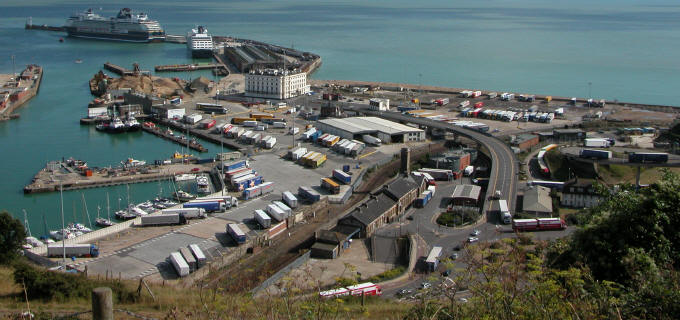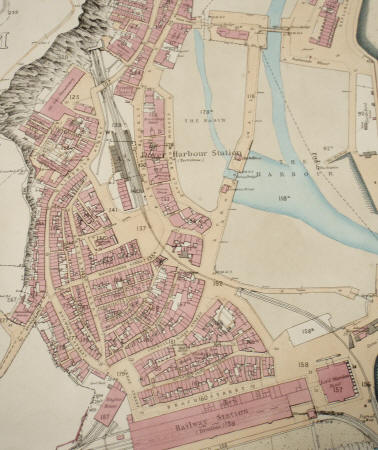| Back |
A Pub Crawl Round The Pier - 1900 |
|
|
|
||
|
This description of a pub crawl round the Pier District in 1900 was found in the local library. Unfortunately there is no author's name or date on it, but he is presumably long departed if he was around at the turn of the last century. It gives an idea of the number of pubs crowded into such a small area of the town around the Admiralty Pier. All spelling and punctuation is as original. I can remember the Pier Coffee Stall in the 1950s, when we used to go for a stroll along the pier or Shakespeare Beach and stop to watch the Golden Arrow pulling out of the Marine Station. In those days there was still quite a lot of housing in the area, and more than a few pubs, but now it is just commercial buildings and lorry parks associated with the docks. The only remaining dwellings can be seen on the centre right of the picture, through the bushes next to the white shed. The picture above shows the Pier District today - The Lord Warden Hotel was the square white building by the pier. The long building with the tall chimney in the centre of the picture was the Harbour Station, in what is left of Elizabeth Street. Beach Street ran along the top of the picture from The Lord Warden Hotel to the right hand side. The Cinque Ports in Clarence Street (the only one of the pubs named below still in operation) can just be seen immediately above and to the left of the large white shed in the centre; the Golden Arrow was the small white building just above the corner of the same shed.
The map (left) shows the Pier District in the late 1800s, with the Lord Warden Hotel bottom right, next to the Dover Town Station. Beach Street can be seen alongside the station, with a veritable warren of little streets, squares and alleys surrounding the Inner Harbour, before the present-day docks were built in The Pent and The Basin. Much of the area was demolished to make way for the railway line which connected the two rival companies' lines when they were merged, providing a link between the Harbour Station and the Folkestone line. Originally, the line passed through a tunnel under Archcliffe Fort (the large, irregularly-shaped area bottom left on the map), but part of the Fort was demolished in the mid 1900s to reduce the sharpness of the curve. (Military areas were always shown on maps as white spaces to prevent potential enemies from getting information) |
||
|
Looking at the Pier District to-day one
would be surprised if he saw it as it was at the turn of the century, and
wonder how so much habitation and business could be sited in such a small
area. The housewife had everything she needed without going out of
the area from the Western Dock Gates to the Lord Warden Hotel now called
Southern House. Now for the menfolk, they could have half-a-pint of beer without using the same public house twice and get drunk on 3/0d. Here is a list of Public Houses in that area in 1900. We start at the Western Docks entrance with 3/0d. and have half-a-pint at each stop :- |
||
|
Prince Imperial |
Strond Street |
|
|
Then, round the corner to Billie
Mutton's, where you could buy a packet of 'fags' for a penny, or a
pennyworth of 'Shag' tobacco. How he could sell it at that price is
nobody's business. From there we go and see Mr. Minoletti at the
Pavilion at Custom House Quay. We will now cross the Railway line to the Shakespeare in Clarence Street, to save going over the same ground twice, we will call at the Fleur-de-Lys in Council House Street, and the Cinque Ports, also in Clarence Street, round the corner to |
||
|
Silver Dragon |
Middle Row Beach Street - do - - do - - do - - do - - do - |
|
| Having consumed one gallon plus, we will call on Bert Marbrook, father of Bert who today has the Pier Coffee Stall and who incidentally is 85 years of age. Marbrook Senior was Landlord of the Hope Inn in Council House Street, where we will also have a pennyworth of bread and cheese to soak it up then to the | ||
|
Endeavour |
Bulwark Street - do - Limekiln Street - do - - do - - do - |
|
| The round the corner to | ||
|
Lion |
Elizabeth Street Oxenden Street Hawkesbury Street Oxenden Street - do - Hawkesbury Street - do - - do - Limekiln Street Finnis Hill |
|
|
Now, all houses were open twenty-four
hours, or near, it was common to see who could drink a half-pint at each
house. I do not remember anyone going the whole thirty-six only
twenty-eight, but that was only a practice run. One could get a
pennyworth of gin, or two-pennyworth of rum, or four-pennyworth of brandy.
Ale was 3d. a pint, beer was 2d. and porter was 1d. Wages being 15/- to 18/- per week I think you will find the percentage about equal, but from the number of public houses in such a small area you will understand where the poverty arose and why it was called the 'Poor Pier'. (section - 5 paragraphs - omitted) ... by the way, we did not use all
the 3/0d. Assuming only twenty-eight half-pints were consumed, that
still left 8d, so what can we do with that without making gluttons of
ourselves? Well lets see a show at the Phoenix for 2d. I know
I feel just about too full to walk so on the tram for 1d. Well what
about a half-pint at the Swan? For he's a jolly good fellow. |
||

